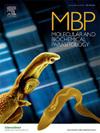Decoding Leishmania in equines: A comparative analysis of molecular targets
IF 1.5
4区 医学
Q4 BIOCHEMISTRY & MOLECULAR BIOLOGY
引用次数: 0
Abstract
Parasitic diseases caused by Leishmania spp. create considerable health concerns in animals, resulting in a considerable financial impact. They causes a complex infection in equines, affecting weight gain, skin, liver, and spleen. To date, there is a lack of reports on the occurrence of Leishmania in equines in Southern Punjab, Pakistan, highlighting the need for molecular epidemiological surveillance. The current study focused on determining the prevalence of Leishmania in the equine population from District Rahim Yar Khan, Southern Punjab, Pakistan, through amplification of mitochondrial (Cytochrome b) and nuclear (18S rRNA) genes of the parasite. For this purpose, a total of 384 equine - i.e. horses, mules, and donkeys - blood specimens, determined by calculation of the sample size formula, were obtained from District Rahim Yar Khan. The parasite was examined through the Microhematocrit method under the microscope. Leishmania was detected from the buffy coat layer after centrifugation of blood-filled microhematocrit tubes. To detect and characterize Leishmania spp.at the molecular level, DNA extraction from blood samples was carried out using standardized commercial kits, followed by PCR amplification. Information on potential risk factors was gathered through a structured questionnaire. The overall prevalence of Leishmania infection was observed to be 2.1 % via microscopy and 7.3 % and 8.8 % by amplification of the 18S rRNA and Cytochrome b genes using molecular methods. A significantly higher infection percentage was observed in female animals compared to males, and in older and underweight animals compared to younger and healthier ones. Additionally, the infection was non-significantly (P ≥ 0.05) more prevalent in gestating, non-dewormed, symptomatic, and poor body condition animals. Phylogenetic and sequence analyses confirmed that the identified gene sequences clustered within the Leishmania (Leishmania) infantum clade, consistent with strains reported in different animal hosts from various regions. In conclusion, the nuclear gene, i.e., 18S rRNA proved to be a more sensitive molecular marker for detecting Leishmania infection in equines compared to the mitochondrial gene, i.e., Cytochrome b.
解码马的利什曼原虫:分子靶点的比较分析。
利什曼原虫引起的寄生虫病在动物中造成相当大的健康问题,造成相当大的经济影响。它们会引起马的复杂感染,影响体重增加、皮肤、肝脏和脾脏。迄今为止,缺乏关于巴基斯坦南旁遮普省马中利什曼原虫发生的报告,这突出表明需要进行分子流行病学监测。目前的研究重点是通过扩增利什曼原虫的线粒体(细胞色素b)和细胞核(18S rRNA)基因,确定利什曼原虫在巴基斯坦南部旁遮普省拉希姆亚尔汗区马种群中的流行情况。为此目的,通过计算样本量公式,从拉希姆亚尔汗区获得了384个马(即马、骡子和驴)的血液标本。显微镜下用微血细胞比容法检查寄生虫。在充满血液的微红细胞压积管离心后,从肉皮层检测利什曼原虫。为了在分子水平上检测和表征利什曼原虫,使用标准化的商用试剂盒从血液样本中提取DNA,然后进行PCR扩增。通过结构化问卷收集潜在风险因素的信息。显微镜下观察利什曼原虫感染的总患病率为2.1%,分子法扩增18S rRNA和细胞色素b基因为7.3%和8.8%。与雄性动物相比,雌性动物的感染率要高得多,与年轻健康的动物相比,老年和体重不足的动物的感染率要高得多。妊娠期、未脱虫、有症状、体况较差的动物感染发生率无统计学意义(P≥0.05)。系统发育和序列分析证实,所鉴定的基因序列聚集在利什曼原虫(利什曼原虫)幼支中,与来自不同地区的不同动物宿主中报道的菌株一致。综上所述,与线粒体基因细胞色素b相比,核基因18S rRNA是检测马利什曼原虫感染的更敏感的分子标记。
本文章由计算机程序翻译,如有差异,请以英文原文为准。
求助全文
约1分钟内获得全文
求助全文
来源期刊
CiteScore
2.90
自引率
0.00%
发文量
51
审稿时长
63 days
期刊介绍:
The journal provides a medium for rapid publication of investigations of the molecular biology and biochemistry of parasitic protozoa and helminths and their interactions with both the definitive and intermediate host. The main subject areas covered are:
• the structure, biosynthesis, degradation, properties and function of DNA, RNA, proteins, lipids, carbohydrates and small molecular-weight substances
• intermediary metabolism and bioenergetics
• drug target characterization and the mode of action of antiparasitic drugs
• molecular and biochemical aspects of membrane structure and function
• host-parasite relationships that focus on the parasite, particularly as related to specific parasite molecules.
• analysis of genes and genome structure, function and expression
• analysis of variation in parasite populations relevant to genetic exchange, pathogenesis, drug and vaccine target characterization, and drug resistance.
• parasite protein trafficking, organelle biogenesis, and cellular structure especially with reference to the roles of specific molecules
• parasite programmed cell death, development, and cell division at the molecular level.

 求助内容:
求助内容: 应助结果提醒方式:
应助结果提醒方式:


